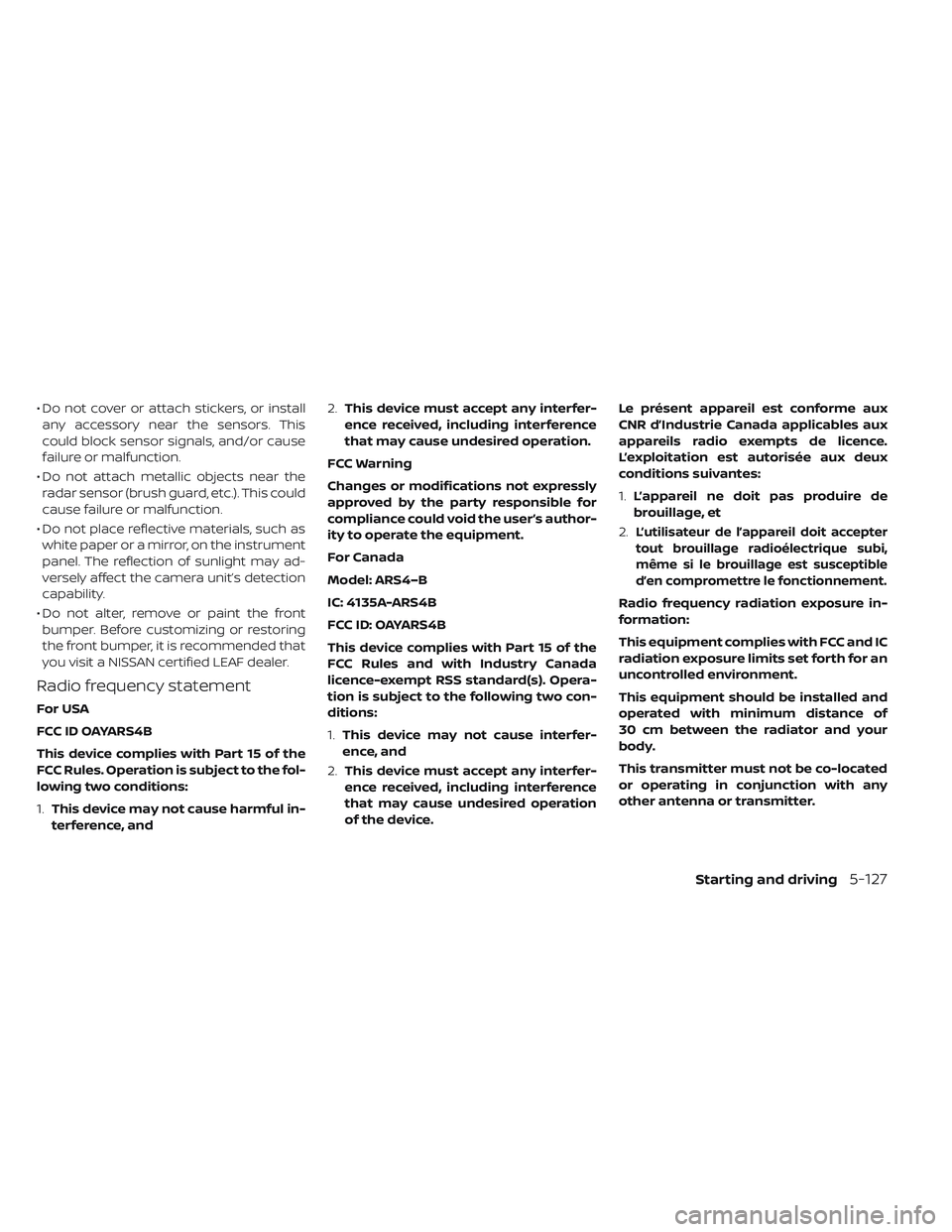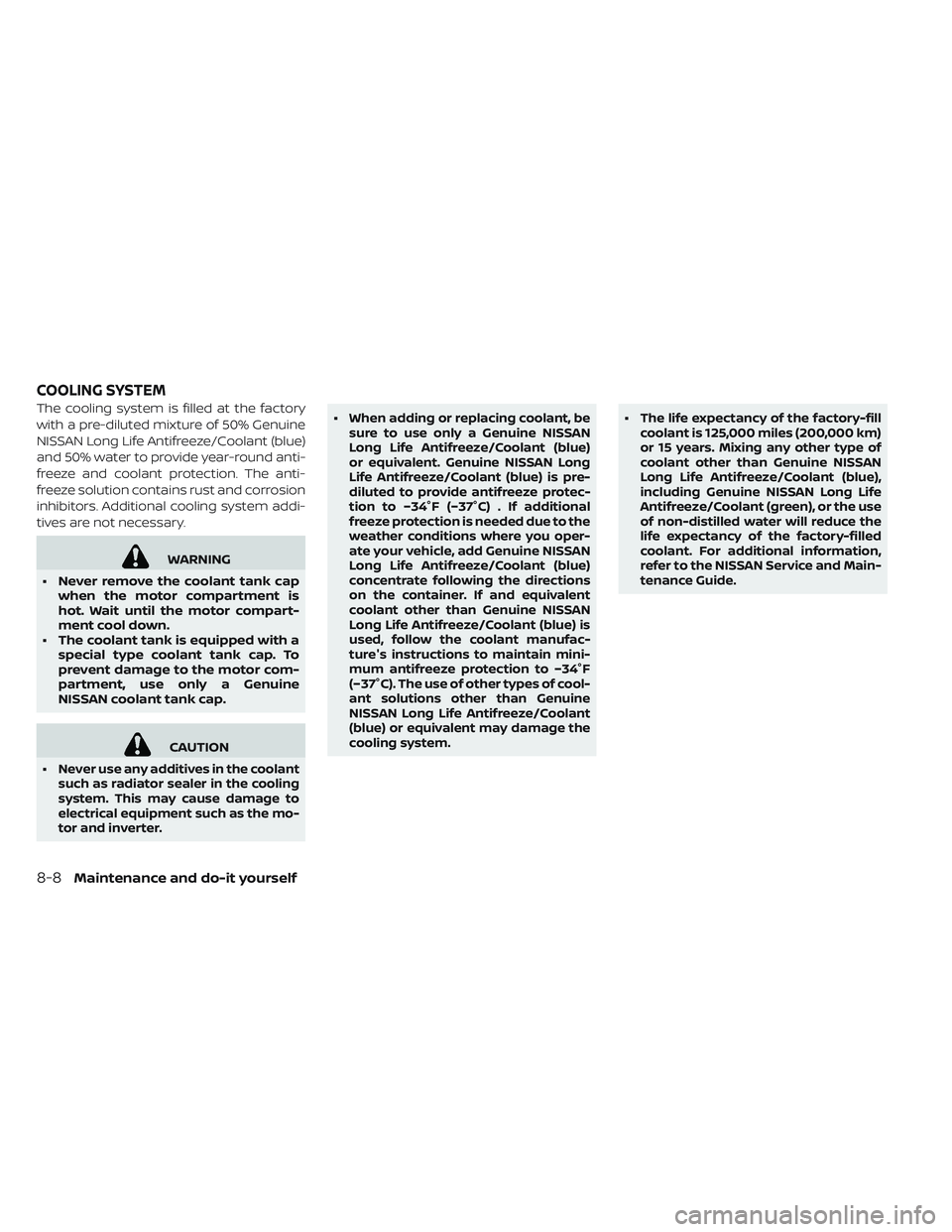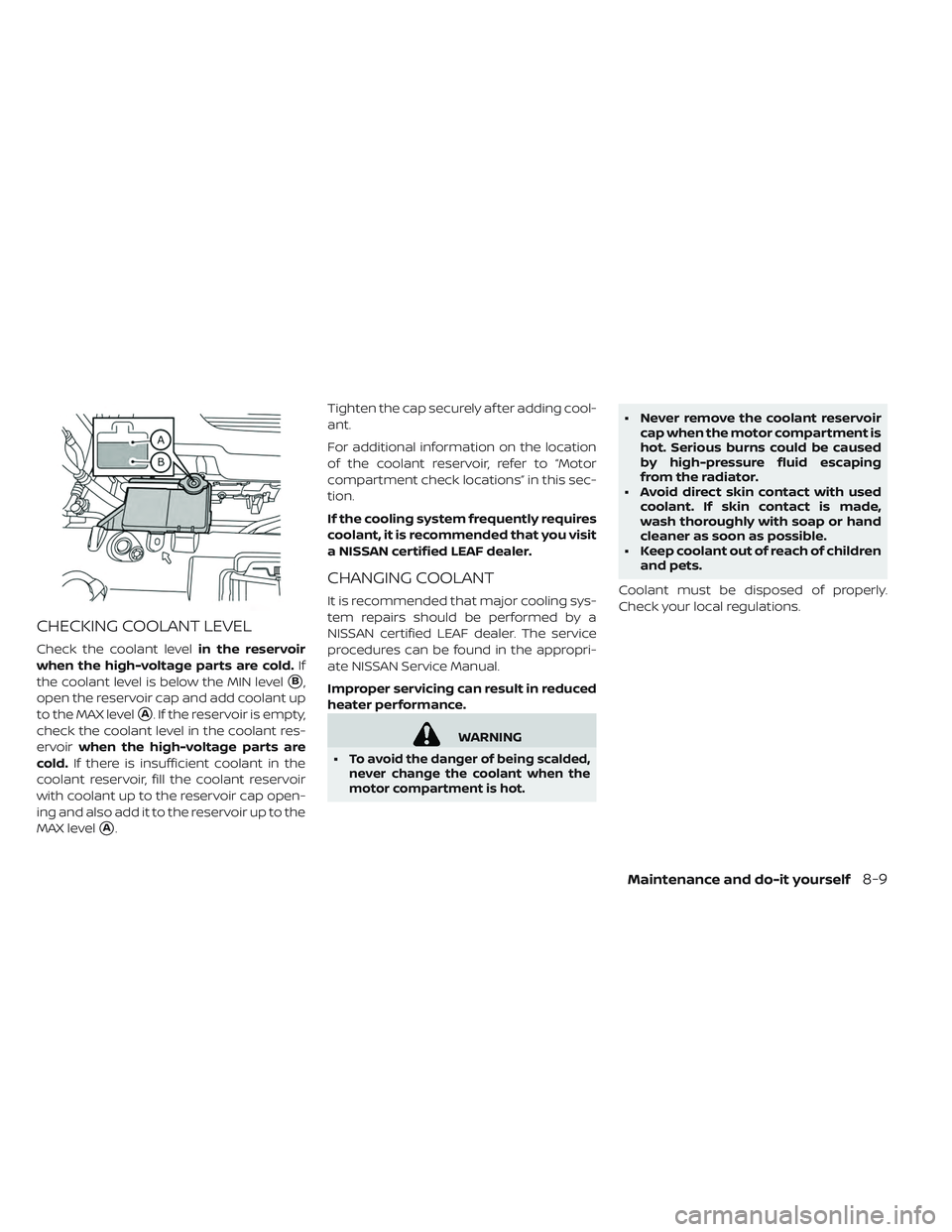Page 486 of 610

• Do not cover or attach stickers, or installany accessory near the sensors. This
could block sensor signals, and/or cause
failure or malfunction.
• Do not attach metallic objects near the radar sensor (brush guard, etc.). This could
cause failure or malfunction.
• Do not place reflective materials, such as white paper or a mirror, on the instrument
panel. The reflection of sunlight may ad-
versely affect the camera unit’s detection
capability.
• Do not alter, remove or paint the front bumper. Before customizing or restoring
the front bumper, it is recommended that
you visit a NISSAN certified LEAF dealer.
Radio frequency statement
For USA
FCC ID OAYARS4B
This device complies with Part 15 of the
FCC Rules. Operation is subject to the fol-
lowing two conditions:
1. This device may not cause harmful in-
terference, and 2.
This device must accept any interfer-
ence received, including interference
that may cause undesired operation.
FCC Warning
Changes or modifications not expressly
approved by the party responsible for
compliance could void the user’s author-
ity to operate the equipment.
For Canada
Model: ARS4–B
IC: 4135A-ARS4B
FCC ID: OAYARS4B
This device complies with Part 15 of the
FCC Rules and with Industry Canada
licence-exempt RSS standard(s). Opera-
tion is subject to the following two con-
ditions:
1. This device may not cause interfer-
ence, and
2. This device must accept any interfer-
ence received, including interference
that may cause undesired operation
of the device. Le présent appareil est conforme aux
CNR d’Industrie Canada applicables aux
appareils radio exempts de licence.
L’exploitation est autorisée aux deux
conditions suivantes:
1.
L’appareil ne doit pas produire de
brouillage, et
2.
L’utilisateur de l’appareil doit accepter
tout brouillage radioélectrique subi,
même si le brouillage est susceptible
d’en compromettre le fonctionnement.
Radio frequency radiation exposure in-
formation:
This equipment complies with FCC and IC
radiation exposure limits set forth for an
uncontrolled environment.
This equipment should be installed and
operated with minimum distance of
30 cm between the radiator and your
body.
This transmitter must not be co-located
or operating in conjunction with any
other antenna or transmitter.
Starting and driving5-127
Page 547 of 610

The cooling system is filled at the factory
with a pre-diluted mixture of 50% Genuine
NISSAN Long Life Antifreeze/Coolant (blue)
and 50% water to provide year-round anti-
freeze and coolant protection. The anti-
freeze solution contains rust and corrosion
inhibitors. Additional cooling system addi-
tives are not necessary.
WARNING
• Never remove the coolant tank cap when the motor compartment is
hot. Wait until the motor compart-
ment cool down.
• The coolant tank is equipped with a special type coolant tank cap. To
prevent damage to the motor com-
partment, use only a Genuine
NISSAN coolant tank cap.
CAUTION
•
Never use any additives in the coolant
such as radiator sealer in the cooling
system. This may cause damage to
electrical equipment such as the mo-
tor and inverter.
•When adding or replacing coolant, be
sure to use only a Genuine NISSAN
Long Life Antifreeze/Coolant (blue)
or equivalent. Genuine NISSAN Long
Life Antifreeze/Coolant (blue) is pre-
diluted to provide antifreeze protec-
tion to −34°F (−37°C) . If additional
freeze protection is needed due to the
weather conditions where you oper-
ate your vehicle, add Genuine NISSAN
Long Life Antifreeze/Coolant (blue)
concentrate following the directions
on the container. If and equivalent
coolant other than Genuine NISSAN
Long Life Antifreeze/Coolant (blue) is
used, follow the coolant manufac-
ture's instructions to maintain mini-
mum antifreeze protection to −34°F
(−37°C). The use of other types of cool-
ant solutions other than Genuine
NISSAN Long Life Antifreeze/Coolant
(blue) or equivalent may damage the
cooling system.•The life expectancy of the factory-fill
coolant is 125,000 miles (200,000 km)
or 15 years. Mixing any other type of
coolant other than Genuine NISSAN
Long Life Antifreeze/Coolant (blue),
including Genuine NISSAN Long Life
Antifreeze/Coolant (green), or the use
of non-distilled water will reduce the
life expectancy of the factory-filled
coolant. For additional information,
refer to the NISSAN Service and Main-
tenance Guide.
COOLING SYSTEM
8-8Maintenance and do-it yourself
Page 548 of 610

CHECKING COOLANT LEVEL
Check the coolant levelin the reservoir
when the high-voltage parts are cold. If
the coolant level is below the MIN level
�B,
open the reservoir cap and add coolant up
to the MAX level
�A. If the reservoir is empty,
check the coolant level in the coolant res-
ervoir when the high-voltage parts are
cold. If there is insufficient coolant in the
coolant reservoir, fill the coolant reservoir
with coolant up to the reservoir cap open-
ing and also add it to the reservoir up to the
MAX level
�A. Tighten the cap securely af ter adding cool-
ant.
For additional information on the location
of the coolant reservoir, refer to “Motor
compartment check locations” in this sec-
tion.
If the cooling system frequently requires
coolant, it is recommended that you visit
a NISSAN certified LEAF dealer.
CHANGING COOLANT
It is recommended that major cooling sys-
tem repairs should be performed by a
NISSAN certified LEAF dealer. The service
procedures can be found in the appropri-
ate NISSAN Service Manual.
Improper servicing can result in reduced
heater performance.
WARNING
•
To avoid the danger of being scalded,
never change the coolant when the
motor compartment is hot.
• Never remove the coolant reservoir cap when the motor compartment is
hot. Serious burns could be caused
by high-pressure fluid escaping
from the radiator.
• Avoid direct skin contact with used coolant. If skin contact is made,
wash thoroughly with soap or hand
cleaner as soon as possible.
• Keep coolant out of reach of children and pets.
Coolant must be disposed of properly.
Check your local regulations.
Maintenance and do-it yourself8-9